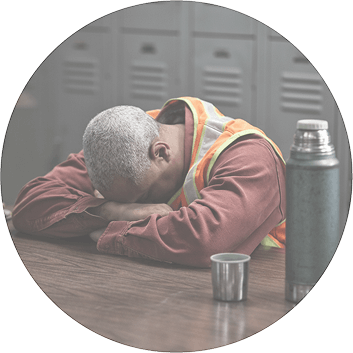Listen up! A podcast version of this article is now available over at The Comp Pod with Andy & Ivy. Visit our YouTube channel https://www.youtube.com/@TheCompPod
The COVID-19 pandemic impacted the world in such an unprecedented manner that the ripple effects continue to be felt – including the prevalence of Long COVID, the chronic condition that can linger for weeks, months, or even years after COVID-19 infection.
In workers’ comp, data has shown that while Long COVID appears in few claims, it significantly impacts medical care and drives up costs. This is likely because Long COVID frequently stems from more intense cases of acute COVID-19 infection, and these claims last longer and require ongoing care as chronic symptoms resurface.
Among COVID claims in workers’ comp, Long COVID made up:
While Long COVID is relatively uncommon in workers’ comp claims, the impacts speak for themselves:
Additionally, even if Long COVID isn’t work-related or covered by workers’ comp, the health impacts of Long COVID have the potential to impact injured worker recovery as a comorbid condition.
This raises the question: what are the health impacts of Long COVID?
Long COVID – also known as post-COVID conditions (PCC), post-COVID-19 syndrome, long-haul COVID, post-acute sequelae of SARS-CoV-2 (PASC) and other names – is a chronic health condition that occurs after COVID-19 infection and is present for at least three months. It is a serious illness that can result in chronic conditions requiring comprehensive care, and can last for weeks, months, or even years after COVID-19. Symptoms can persist, resolve, and re-emerge over weeks and months.4
The CDC found that more than 200 Long COVID symptoms have been identified, but what follows are the more commonly reported symptoms:5
such as difficulty breathing, coughing, or shortness of breath
such as fast-beating heart or a pounding heart
a worsening of symptoms after exercise, social activity, and emotional stressors
such as diarrhea, stomach pain, and constipation
Prevalence and At-Risk Populations for Long COVID
In 2022, the CDC found that 6.9% of adults had Long COVID at some point in time,6 while the National Academies of Sciences, Engineering, and Medicine estimates that 8.9 million Americans had Long COVID symptoms in 2022.7
The likelihood of Long COVID increases with age, while women, Hispanic/Latino populations, and those unvaccinated against COVID-19 are more likely to get Long COVID.4
According to data from California, across industries there was a higher prevalence for Long COVID found in the healthcare, manufacturing, and retail industries.8
Within workers’ comp, injured workers who received more intensive medical interventions during the acute stages of COVID-19 were more likely to receive care for Long COVID.1
Among injured workers who received ICU care for COVID-19 – less than 1% of those with COVID claims – 74% of those workers received treatment for Long COVID.1
Furthermore, injured worker patients in California with pre-existing comorbidities had a 50% higher prevalence of developing Long COVID.8
Long COVID can be a disability under the Americans with Disabilities Act (ADA) if it substantially limits one or more major life activities. This means that businesses or state or local governments will sometimes need to make changes to their operations to accommodate a person’s Long COVID-related limitations.9
Whether or not a case of Long COVID is directly covered by workers’ comp or viewed as a comorbidity occurring alongside an unrelated workplace injury, there are many ways the health complications of Long COVID can impact claims, from wound recovery to organ damage and muscle weakness.

COVID‐19 can prolong primary wound healing by inducing excessive inflammation and oxidative stress, disturbing the immune and hematologic systems, as well as influencing the functions and viability of epidermal stem cells.10
If an injured worker’s wounds take longer to heal, that could extend recovery, the life of a claim, and the need for additional treatment.
Multi-organ injuries are observed in more severe cases of COVID-19, potentially impacting the lungs, heart, kidneys, and liver.11
For patients who suffer organ damage resulting from a severe case of COVID-19 and then go on to develop Long COVID, any lasting damage caused during the initial COVID-19 infection can go on to be a complicating factor. Considering that Long COVID is more likely to develop after more extreme cases of COVID-19, these symptoms are incredibly relevant when navigating pharmacy management across patients with Long COVID.
If an injured worker sustained organ damage from initial COVID-19 infection, medications commonly utilized in workers’ comp may not be compatible due to potential drug-drug and drug-disease interactions.
The WCRI found that from Q1 2021 to Q1 2023, half of the prescriptions in COVID-19 claims were for respiratory medications, and that 64% of workers with Long COVID had lung-related conditions.12, 1
Boxed Warning for life-threatening respiratory depression; contraindicated in patients with significant respiratory depression13-14
Usage of diazepam is contraindicated in patients with severe respiratory insufficiency and severe hepatic insufficiency15
In patients with hepatic impairment (liver damage), it is recommend to start patients at the lowest possible dose of alprazolam16
Boxed Warning for hepatotoxicity/acute liver failure; contraindicated in patients with severe liver impairment or severe active liver disease; use with caution in patients with liver impairment or active liver disease17
Cyclobenzaprine use in patients with hepatic impairment (liver dysfunction) is not recommended for the extended-release formulation. Immediate release formulations may require dosage adjustments18
Cyclobenzaprine is contraindicated in patients with acute myocardial infarction (heart attack), arrhythmia, heart block or conduction disturbances, or congestive heart failure19
Boxed Warning for serious cardiovascular thrombotic events, including myocardial infarction (heart attack) and stroke20
Use of baclofen in patients with impaired renal function(kidney problems) may require reduced dosage21
NSAIDs could cause kidney failure and patients are advised to discuss kidney problems with their doctor20

Long COVID symptoms can include post-exertional malaise, a condition that causes high fatigue after light physical activity, social activity, and emotional stress.5 Additionally, in a study by Nature that compared pre-and-post-exercise biopsies between Long COVID patients and healthy controls, Long COVID patients displayed significant muscle damage, a disturbed immune response, and a buildup of microclots.22
In fact, a report from the CDC found that for workers with Long COVID, returning to work too early can result in health deterioration, noting the importance of prolonged reconditioning and gradually reintroducing patients back into the workplace.23
This can impact return-to-work strategies for various occupations, particularly those with high physical demands.
A systematic review from Diseases noted a positive implication for the advancement of physical activity as a therapeutic intervention for individuals with Long COVID-19.24
While more research is needed into the subject, this does mean certain forms of physical therapy modalities could benefit Long COVID patients.
However, due to the possible presence of fatigue and muscle weakness, this could reduce the pace at which patients could engage with physical therapy.
If physical therapy is found to be an effective tool, this could impact the utilization of physical therapy in these patient populations.

Addressing Long COVID requires a multi-pronged approach, as the complexities of this condition can vary significantly.
Considering how recent COVID-19 and Long COVID are, there is still ongoing research to determine optimal treatment strategies for Long COVID. Additionally, while the pandemic has ended, new COVID variations continue to emerge, which could result in new cases of Long COVID. Understanding evolving risks, prevention strategies, and treatments remains important.
Not all cases of Long COVID qualify for disability status, but those that do entitle individuals to reasonable accommodations. Workplace accommodations can include but are not limited to rest breaks, a plan of action during flare-ups, remote work when applicable, and periods of intermittent leave to aid in recovery.25
Considering certain physical and neurological challenges of Long COVID, it may be beneficial to provide alternate work assignments and environments to accommodate workers with Long COVID who are returning to the workforce. A more gradual reintroduction to the job could be beneficial in recovery.
In response to the possible prescription drug management concerns that can accompany Long COVID in workers’ comp, workers’ comp payers can leverage the clinical expertise and capabilities of their PBM and/or medical management partners to address potential complexity. Example capabilities include:
Long COVID represents another recent example of how risk impacting a small portion of workers’ compensation can have a significant impact on cost and claims outcomes, depending on the demographics of a payer’s covered population. Healthesystems continues to monitor and report on such evolving risks.
